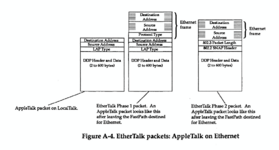cheesestraws
Well-known member
As a companion / follow-on piece to AirTalk, I've been considering trying to build a new AppleTalk router (either just software or a software/hardware combination) aimed at hobbyists. I'm starting this thread to try to get some opinions and/or interest going around what, in broad terms, this should look like. I'm especially shamelessly pinging @NJRoadfan, @slipperygrey and @mactjaap for opinions as people I know have delved into Dark AppleTalk Magic recently, but please everyone else jump in too.
Let's start with "why not use netatalk's routing?" as a starting point. I think this will give us a good set of starting points, because netatalk is good software but aimed at a very different use case from the home user/hobbyist situation.
This all sounds more like a low-end bridge. So, why not just use one of those?
So, taken as a starting point, we seem to be converging on something that has the kind of plug and play experience as the AsantéTalk or the Farallon iPrint boxes but which does proper AppleTalk routing—a luxury we can now afford because of faster CPU speeds.
What do people think?
Let's start with "why not use netatalk's routing?" as a starting point. I think this will give us a good set of starting points, because netatalk is good software but aimed at a very different use case from the home user/hobbyist situation.
- Netatalk is really for managing networks with large numbers of computers in complicated topologies. This can be fun to fiddle with, but for people who just want to be able to string computers together, it's a serious detriment. The proposed system should be designed to be easy to use with 20 computers, not 200.
- Netatalk heavily relies on the underlying AppleTalk support in the kernel and specifically will only try to talk AppleTalk on things that the underlying OS thinks are network links. Again, this makes a lot of sense in the context it was designed for, but means that to add support for things like TashTalk would either require kernel-level driver writing, prosthetic bridging to Ethernet, or refactoring of netatalk. The proposed system should be designed to maintain a distinction between an AppleTalk "port" and a layer 2 network interface.
- Netatalk has lots of complicated options. The bridges and routers that made most inroads into the end-user space had very few verging on none. They just plugged LocalTalk into Ethernet. Apple Internet Router sits rather in the middle: it provides quite a few features, but not a huge amount of detail on those features. Personally I find this just as frustrating, because you can break something and it won't tell you exactly why. The proposed system should have extremely simple configuration based on sane defaults, but should allow people to see what's gone wrong in detail if something does.
- Netatalk modifies its own configuration based on soft-seeding and AppleTalk hints. The proposed system should always be reset to a known state by a power cycle even if this slightly slows down startup.
This all sounds more like a low-end bridge. So, why not just use one of those?
- They're not very available. The proposed system should... um.... exist?
- They tend to have a very simplistic view of the structure of the network. Nowadays, people like using netatalk for file sharing (which can sometimes result in network complications). I want this also to work with AirTalk, so that's a three-lobed network, not a two-way conversion, and I think it'd be useful for it to do be able to play nicely with things like long-distance AppleTalk over the internet or ARA (as I know we have members playing with that). So the proposed system must tolerate and play nicely with network complexity without enforcing it.
- Some of them do hair-raising things to support Phase I EtherTalk. The proposed system should only speak protocols anyone cares about: does anyone use Phase I EtherTalk?
So, taken as a starting point, we seem to be converging on something that has the kind of plug and play experience as the AsantéTalk or the Farallon iPrint boxes but which does proper AppleTalk routing—a luxury we can now afford because of faster CPU speeds.
What do people think?

